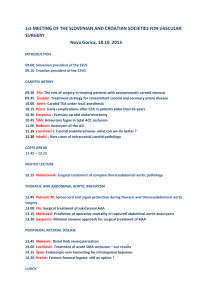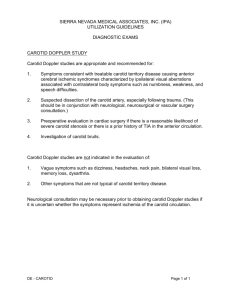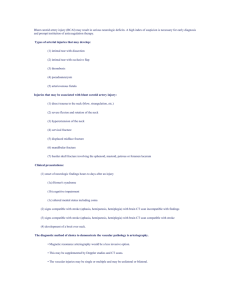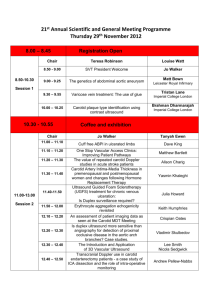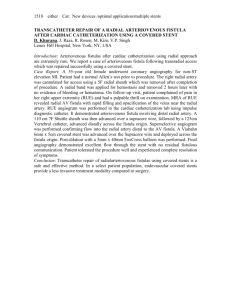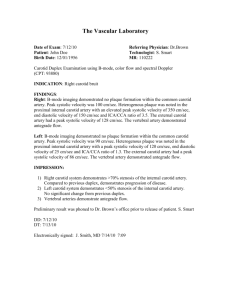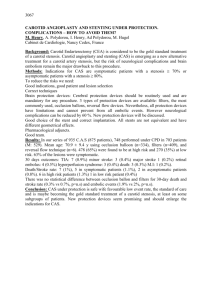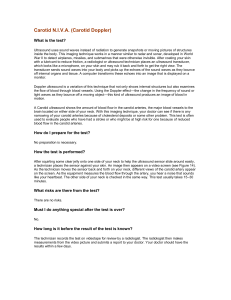Treatment of a Rare Congenital External Carotid Arteriovenous
advertisement
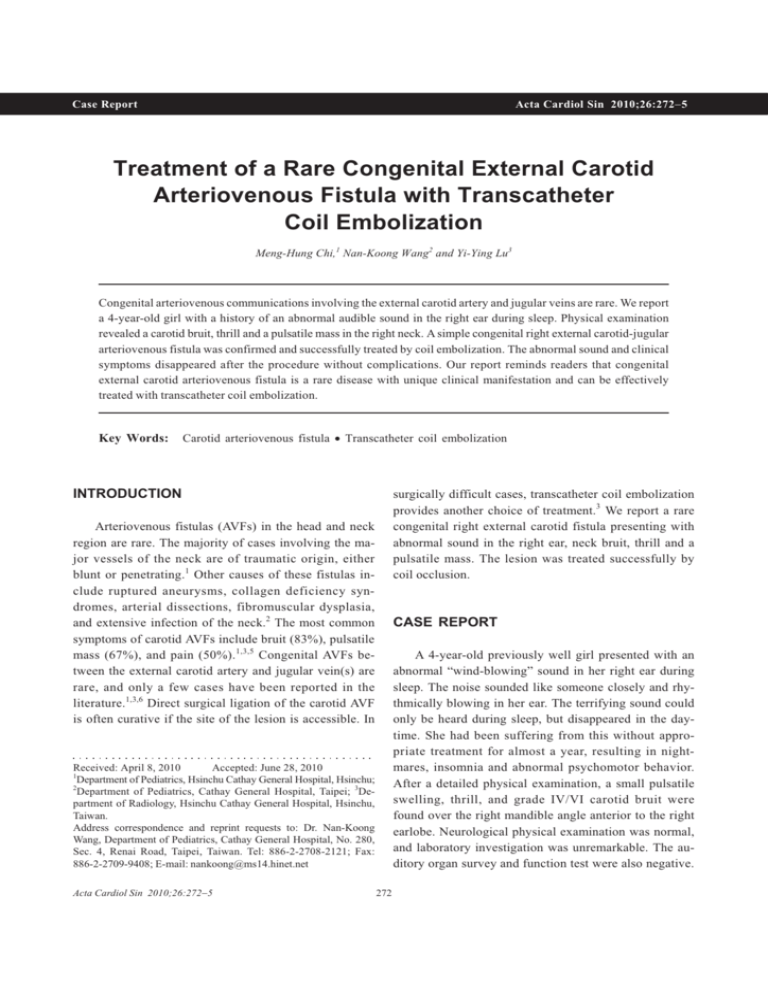
Congenital External Carotid Artery Fistula Case Report Acta Cardiol Sin 2010;26:272-5 Treatment of a Rare Congenital External Carotid Arteriovenous Fistula with Transcatheter Coil Embolization Meng-Hung Chi,1 Nan-Koong Wang2 and Yi-Ying Lu3 Congenital arteriovenous communications involving the external carotid artery and jugular veins are rare. We report a 4-year-old girl with a history of an abnormal audible sound in the right ear during sleep. Physical examination revealed a carotid bruit, thrill and a pulsatile mass in the right neck. A simple congenital right external carotid-jugular arteriovenous fistula was confirmed and successfully treated by coil embolization. The abnormal sound and clinical symptoms disappeared after the procedure without complications. Our report reminds readers that congenital external carotid arteriovenous fistula is a rare disease with unique clinical manifestation and can be effectively treated with transcatheter coil embolization. Key Words: Carotid arteriovenous fistula · Transcatheter coil embolization INTRODUCTION surgically difficult cases, transcatheter coil embolization provides another choice of treatment.3 We report a rare congenital right external carotid fistula presenting with abnormal sound in the right ear, neck bruit, thrill and a pulsatile mass. The lesion was treated successfully by coil occlusion. Arteriovenous fistulas (AVFs) in the head and neck region are rare. The majority of cases involving the major vessels of the neck are of traumatic origin, either blunt or penetrating.1 Other causes of these fistulas include ruptured aneurysms, collagen deficiency syndromes, arterial dissections, fibromuscular dysplasia, and extensive infection of the neck.2 The most common symptoms of carotid AVFs include bruit (83%), pulsatile mass (67%), and pain (50%).1,3,5 Congenital AVFs between the external carotid artery and jugular vein(s) are rare, and only a few cases have been reported in the literature.1,3,6 Direct surgical ligation of the carotid AVF is often curative if the site of the lesion is accessible. In CASE REPORT A 4-year-old previously well girl presented with an abnormal “wind-blowing” sound in her right ear during sleep. The noise sounded like someone closely and rhythmically blowing in her ear. The terrifying sound could only be heard during sleep, but disappeared in the daytime. She had been suffering from this without appropriate treatment for almost a year, resulting in nightmares, insomnia and abnormal psychomotor behavior. After a detailed physical examination, a small pulsatile swelling, thrill, and grade IV/VI carotid bruit were found over the right mandible angle anterior to the right earlobe. Neurological physical examination was normal, and laboratory investigation was unremarkable. The auditory organ survey and function test were also negative. Received: April 8, 2010 Accepted: June 28, 2010 1 Department of Pediatrics, Hsinchu Cathay General Hospital, Hsinchu; 2 Department of Pediatrics, Cathay General Hospital, Taipei; 3Department of Radiology, Hsinchu Cathay General Hospital, Hsinchu, Taiwan. Address correspondence and reprint requests to: Dr. Nan-Koong Wang, Department of Pediatrics, Cathay General Hospital, No. 280, Sec. 4, Renai Road, Taipei, Taiwan. Tel: 886-2-2708-2121; Fax: 886-2-2709-9408; E-mail: nankoong@ms14.hinet.net Acta Cardiol Sin 2010;26:272-5 272 Congenital External Carotid Artery Fistula There was no history of head or neck trauma. Magnetic resonance angiography of the head and neck revealed: (1) an engorged right common carotid artery (CCA), engorged right external carotid artery (ECA), and early abnormal delineation of the right external jugular vein (EJV) and right internal jugular vein (IJV); and (2) a fistula about 0.3 cm in width connecting the ECA to the EJV and IJV (Figure 1). Right common carotid angiography revealed a dilated CCA, ectasia of the ECA, and rapid opacification of the EJV and IJV through the narrowed fistula (Figure 2A). Selective right external carotid angiography clearly delineated a simple short-segmental fistula in the distal portion of the ECA that supplied the EJV and IJV (Figure 2B). The contour of the distal ECA was smooth, and no major distal branches near the fistula were seen. The right ECA was engorged, with a maximum diameter of around 8 to 10 mm, but connected to a terminal fistula with a minimum diameter of 2 to 3 mm. Two coils (COOK Inc., Embolization Coil, MWCE 38-8-5) were carefully deployed in the distal end of the ECA to occlude the fistula. Post-coil right ECA angiography revealed complete obliteration of the lesion without residual shunt (Figure 2C). The patient’s carotid bruit and thrill disappeared after coil intervention. The patient remained well with complete resolution of the symptoms. The post-coil course was uneventful, without any complications or recurrence for five years. veins arise through differentiation from a common capillary plexus. During embryologic development, certain vessels may function as arteries at one stage of embryonic life and as veins at another. If some of the connections that are normally obliterated remain patent, they may develop into abnormal arteriovenous connections or into some other vascular abnormality.6 The symptoms caused by carotid AVFs are mainly dependent on the severity of the shunt. The most frequently presenting symptoms are pulsatile tinnitus, bruit and/or thrill, ocular problems, headache, pain and a pulsatile mass in the neck.1,3,5 A pulsatile mass beneath the earlobe or at the mandibular angle usually presents from birth. Cardiac failure can occur in patients, especially in newborns, depending on the size of the artery involved, its situation to the arch of the aorta, the size of the fistula and its duration.8 A special buzzing or ringing noise synchronous with the pulse in the homolateral ear may be heard, and vertigo may also occur.9,10 “Pulsatile tinnitus” describes such kind of audible symptom produced by very high-speed shunting turbulent blood flow near the auditory organ.9,10 Such sounds are so unusual that they are found in only 3% of all cases of tinnitus and might be a clue to suggest a carotid AVF.9 Our patient experienced this unexplained tinnitus in her DISCUSSION Arteriovenous fistulas of the head and neck are quite rare. AVFs involving the great vessels of the neck are usually secondary to penetrating trauma, or iatrogenic causes.2 Congenital AVFs in head and neck are relatively rare compared to the secondary cases, and usually appear early in life. 1,4-6 A literature review revealed less than twenty cases of congenital origin involving the external carotid artery and the jugular vein(s).6 Histopathogenesis of cervicofacial fistulas has been studied in the forelimbs of pig and chick embryos. Persistence of embryonic communications between the primordia of arteries and those of veins originating from identical mesenchymal tissue seems to be the basis for congenital AVF.6 In the human fetus, both arteries and Figure 1. Magnetic resonance angiography of the neck revealing engorgement of the right common carotid artery (big arrow), right external carotid artery, right external jugular vein (small arrow, EJV), and right internal jugular vein (small arrow, IJV); and the fistula (open arrow). 273 Acta Cardiol Sin 2010;26:272-5 Meng-Hung Chi et al. B A C Figure 2. (A) Right common carotid angiogram delineating the engorged right common carotid artery (big black arrow), tortuous ectasia of the right external carotid artery (small black arrow), and rapid opacification of the right external jugular vein (small white arrow, EJV), and right internal jugular vein (white arrow, IJV) via the fistula. (B) Selective right external carotid angiogram clearly revealing a simple narrowed segmental fistula located around the mandible angle and remarkably prominent right external jugular vein. (C) Post-coil right common carotid angiography revealing totally occlusion of the congenital fistula. edly enhances the diagnostic ability, efficacy, and accuracy in carotid AVFs.10 A delicate MRA of the surrounding anatomy and vascularities provides more detailed information about the overall vascular drainage, collateral circulation, and possible fistula-unrelated vascular malformations.10 Powerful MRA imaging, carrying a lower risk than traditional angiography nowadays, is the standard diagnostic tool for carotid AVFs.8-10 Symptomatic or complicated carotid AVFs such as those causing pain, hemorrhage, pressure symptoms, ischaemic ulceration and even congestive cardiac failure may necessitate an attempt at surgical excision. Carotid AVFs, if untreated, may lead to a number of well-known complications, most importantly cardiac failure, rupture, or emboli. In the past, treatment of choice was primary reliant on surgical excision or ligation of the feeding right ear during sleep for a year, resulting in insomnia. Based on all negative findings in auditory investigation, the girl was even diagnosed to have a psychological problem and underwent several religious therapies. The tinnitus was cured ultimately and she slept well after coil embolization. The diagnosis of a carotid AVF is usually made without difficulty, but the vessels involved should be precisely identified with angiography. 8 Doppler ultrasonography of the neck is invaluable, especially in the young, for screening and follow-up, but is not as precise as angiography. Doppler ultrasound diagnosis in our case failed to delineate the image of the fistula, perhaps due to the deeper location of the lesion site, limitation of the acoustic window, and bony artifact of the ultrasound signal. Magnetic resonance angiography (MRA) markActa Cardiol Sin 2010;26:272-5 274 Congenital External Carotid Artery Fistula carotid fistula is a safe and effective procedure. After a detailed MRA and angiography assessment, a simple narrowed fistula without distal collateral branches guarantees the success of coil occlusion and low risk of complications. arteries. In a simple narrowed isthmus-like fistula without collateral circulation, transcatheter embolization may be sufficient, safe, and effective.4,5 Detachable balloons or coil materials represent the safest and the preferred devices for occlusion of carotid AVFs in many reported cases.1,3-5 Aiming at abolition of the fistula, while maintaining the patency of the remaining branches of the carotid artery, makes the detachable balloon the preferred approach.3,4 Small-diameter coils are useful when it is impossible to pass a balloon through the narrow orifice of the fistula, or when the venous portion of the fistula is not large enough to inflate the balloon.3-5 Although good outcomes can be achieved, only a certain number of suitable fistulas are amenable to closure with coil technique. Coil embolization of a large, high-flow carotid AVF carries a certain risk for migration of embolic material through the fistula and into the venous outflow. Careful catheter manipulation, appropriate coil material selection, and precise pre-coil evaluation can prevent the risk and later complications.4-8 Suitable candidate for traditional coil occlusion includes a single narrow drainage site, absence of multiple fistulas, absence of large branch vessels, appropriate size of the fistula, and safe accessibility to the lesion. Our case was a simple congenital fistula with a minimum ECA diameter of 2 to 3 mm. We used two coils (MWCE 38-8-5) to achieve complete abolition. Usually, the coil diameter (5 mm) must be 1.5-fold greater than the minimum diameter of feeding artery (2 to 3 mm) to confirm the coil fixation and to prevent dislodgement. In summary, transcatheter coil embolization for REFERENCES 1. Kohout MP, Hansen M, Pribaz JJ, et al. Arteriovenous malformations of the head and neck: natural history and management. Plast Reconstr Surg 1998;102:643-54. 2. Halbach VV, Higashida RT, Hieshima GB. Treatment of vertebral arteriovenous fistulas. AJR Am J Roentgenol 1988;150:405-12. 3. Halbach VV, Higashida RT, Hieshima GB, et al. Arteriovenous fistula of the internal maxillary artery: treatment with transarterial embolization. Radiology 1988;168:443-5. 4. American Society of Interventional and Therapeutic Neuroradiology. External carotid artery embolization. AJNR Am J Neuroradiol 2001;22:S12-3. 5. Berenstein A, Scott J, Choi IS, et al. Percutaneous embolization of arteriovenous fistulas of the external carotid artery. AJNR Am J Neuroradiol 1986;7:937-42. 6. Tekkok IH, Akkurt C, Suzer T, et al. Congenital external carotidjugular fistula: report of two cases and a review of the literature. Neurosurgery 1992;30:272-6. 7. Fraser GR. Congenital internal carotid-internal jugular fistula. J Pediatr 1971;79:343-4. 8. Zilkha A, Schechter MM. Arteriovenous fistulas of the major vessels of the neck. Acta Radiol Diagn (Stockh) 1969;9:560-72. 9. Herraiz C, Aparicio JM. Diagnostic clues in pulsatile tinnitus (somatosounds). Acta Otorrinolaringol Esp 2007;58:426-33. 10. Dietz RR, Davis WL, Harnsberger HR, et al. MR imaging and MR angiography in the evaluation of pulsatile tinnitus. AJNR Am J Neuroradiol 1994;15:879-89. 275 Acta Cardiol Sin 2010;26:272-5

